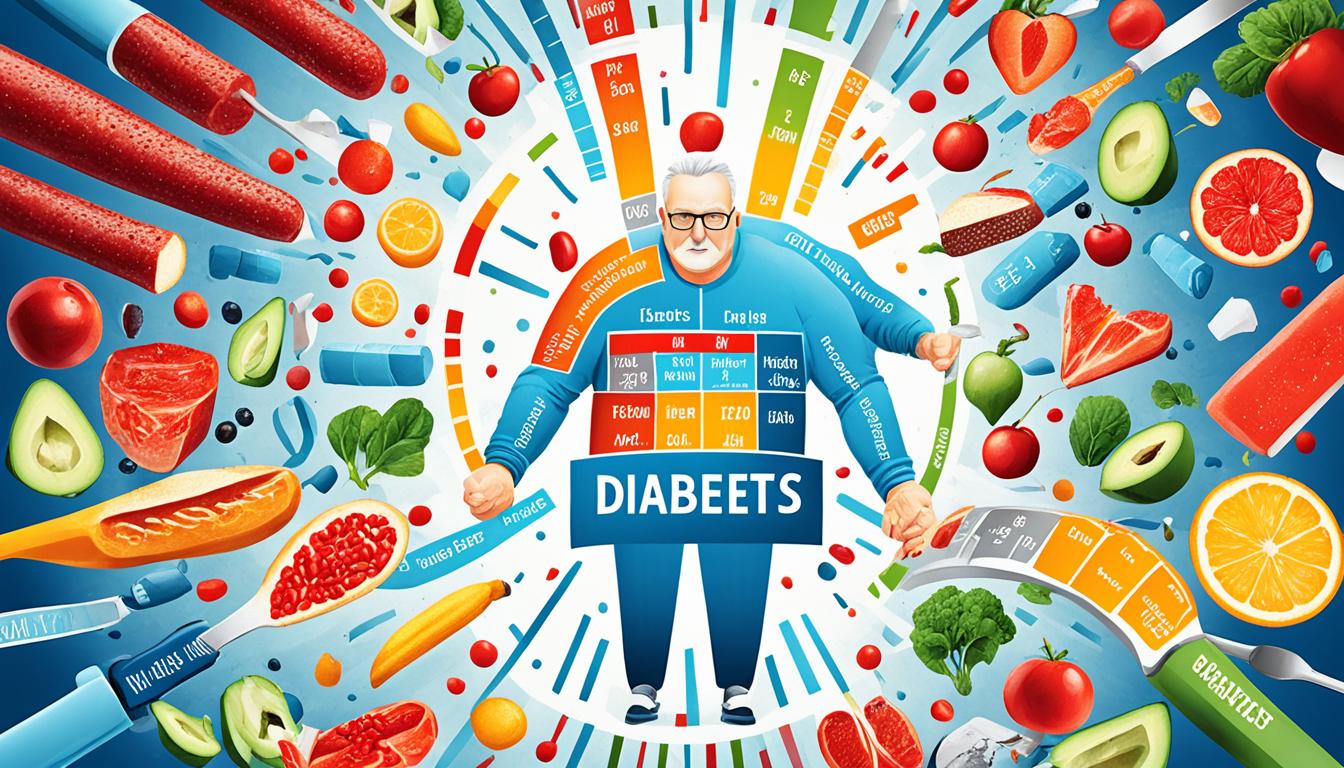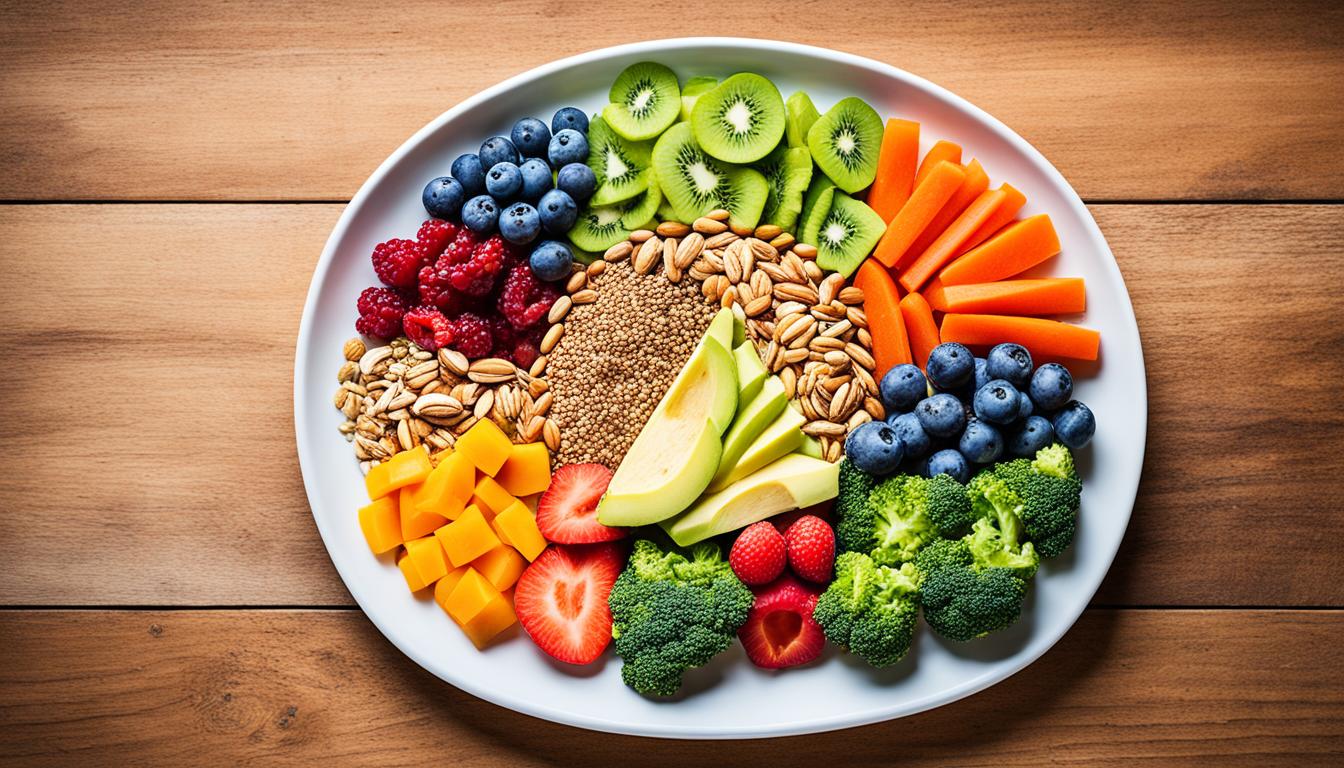Fighting Diabetes: Effective Strategies & Tips

Diabetes affects 37.3 million Americans, with another 96 million at risk of getting it1. But, many cases can be prevented or managed with lifestyle changes. This article will share tips on fighting diabetes. We’ll cover diet, exercise, taking meds, and managing stress.
Key Takeaways
- Losing just 7-10% of body weight can significantly reduce the risk of developing diabetes.
- Incorporating 150 minutes of moderate to vigorous exercise per week, along with resistance training, can promote weight loss and overall health.
- Consuming a fiber-rich diet can help slow the absorption of sugars, lower blood pressure, and manage diabetes risk factors.
- Routine screening for type 2 diabetes is recommended for adults aged 45 and older, as well as younger individuals with specific risk factors.
- Quitting smoking and reducing sedentary behavior can lower the risk of developing diabetes and related complications.
How to Fight Diabetes: Adopt a Healthier Lifestyle
People who are overweight or obese struggle with Type 2 diabetes. This makes them more likely to have high blood cholesterol and high blood pressure. These are big risks for heart disease2. To beat diabetes, losing weight and moving more is key.
Lose Excess Weight
Just losing a bit of weight, 5-7% of your total, can really cut down your risk of type 2 diabetes2. Eating less sugar and less saturated fat helps too. Aim to keep sugar under 10% of your daily calories and saturated fat under 10%2.
Increase Physical Activity
Being active, like 30 minutes of moderate exercise daily, can make your body more sensitive to insulin and lower blood sugar2. Healthy adults should do at least 150 minutes of moderate exercise or 75 minutes of hard exercise each week2. Adding exercise and managing your weight can cut your diabetes risk by more than half2.
Living healthier by losing weight and moving more can really help fight diabetes and lower health risks2. Remember, small, steady changes can greatly improve your health2.
Dietary Changes to Prevent and Manage Diabetes
Making the right food choices is key to preventing and managing diabetes. A good diabetes diet helps control blood sugar, manage weight, and lowers the risk of complications3.
Reduce Carbohydrate and Sugar Intake
Reducing refined carbs and added sugars is a top strategy for diabetes management. These foods cause quick spikes in blood sugar, making it hard to keep glucose levels healthy4. Instead, eat complex carbs from whole, fiber-rich foods like fruits, veggies, and whole grains. These foods help control blood sugar more slowly.
Eat More Fiber-Rich Plant Foods
Adding more fiber-rich plant foods to your diet helps prevent and manage diabetes. Foods like fruits, veggies, whole grains, and legumes are full of fiber, low in calories, and packed with nutrients3. Fiber slows down carb absorption, leading to stable blood sugar levels and helping with weight control.
Also, eating more plant-based foods brings many health benefits. It lowers the risk of heart disease, some cancers, and other chronic conditions3. By changing your diet, people with diabetes can better control their blood sugar, manage their weight, and boost their health.

“Dietary choices play a significant role in keeping blood sugar levels in check and preventing diabetes complications.”3
The Role of Hydration in Diabetes Management
Drinking water is key to managing diabetes. Sugary drinks like soda raise blood sugar levels5. But, drinking more water can help control blood sugar and improve insulin response6. It’s vital for people with diabetes, as they easily get dehydrated in the heat7.
How much water you need depends on your age, activity, climate, weight, and health6. About 20% of fluids come from foods like veggies and fruits6. But most fluids should be from water. Not drinking enough can make you feel tired and sick6.
Diabetes happens when the body can’t make enough insulin, causing high blood sugar7. Diabetics’ overworked kidneys may lose too much sugar in urine, leading to dehydration7. Drinking more fluids can make you urinate more, which might worsen dehydration7. To lower blood sugar fast, you can drink water, increase your heart rate, eat a snack high in protein, or use quick-acting insulin7.
Dehydration and diabetes often go together. Feeling thirsty and having a dry mouth are early signs of diabetes5. If you have severe dehydration or diabetic ketoacidosis symptoms like confusion or fruity breath, see a doctor5.
| Recommended Fluid Intake for People with Diabetes | Women | Men |
|---|---|---|
| Recommended Daily Fluid Intake | 1.6 liters (6.5 cups) | 2 liters (8.5 cups) |
Staying hydrated helps people with diabetes manage their condition and lowers the risk of problems5. A healthcare professional can help figure out the right amount of fluid you need5.

“Proper hydration is essential for individuals with diabetes, as it can help stabilize blood sugar levels and prevent dehydration-related complications.”
How to Fight Diabetes by Quitting Smoking
Smoking is a big risk for type 2 diabetes. Smokers are 30% to 40% more likely to get diabetes than those who don’t smoke8. Nicotine in tobacco can raise blood sugar and add belly fat, which can lead to insulin resistance and diabetes8. Smokers with diabetes often need more insulin to control their blood sugar8.
But quitting smoking can really help lower diabetes risk and its problems. Just 12 hours after quitting, your blood’s carbon monoxide levels go back to normal. In 2-3 months, your lungs and blood circulation get better8. After a year without smoking, your risk of heart disease cuts in half8.
Using nicotine replacement like gum or patches can double your chance of quitting8. Getting support from loved ones or professionals can also help you quit for good8. People with diabetes who stop smoking are less likely to face serious issues like heart or kidney disease8.
Actually, smoking kills about 9,000 people in the U.S. each year because of diabetes9. Just eight weeks after quitting, insulin works better at controlling blood sugar9. With the right support and effort, quitting smoking can be a key step against diabetes.
Signing up for a program like the “I Quit” program and staying smoke-free for 28 days can boost your chances of quitting a lot10. If you make it to 28 days, you can get a $50 HPB eVoucher, with more vouchers later10. Calls to the 1800 service line might cost money, but landline calls are free10.
“Quitting smoking is one of the most important things people with diabetes can do to improve their health and reduce their risk of complications.”
Portion Control: A Key Strategy to Fight Diabetes
Keeping an eye on portion sizes is key in fighting diabetes. It helps manage blood sugar and aids in losing weight. Both are vital for preventing and managing diabetes1112.
The plate method is a great way to control portions. It splits the plate into areas for veggies, lean protein, and carbs13. The Diabetes Plate suggests filling half with veggies, a quarter with protein, and the rest with carbs like whole grains and fruits13.
| Food Item | Recommended Portion Size |
|---|---|
| Cooked rice | 2 heaped tablespoons11 |
| Semi or skimmed milk | one medium glass (200ml or 1/3 pint)11 |
| Cooked lean meat (e.g., chicken, beef, or pork) | deck of playing cards (60–90g)11 |
| Grapes | one handful11 |
| Cooked vegetables (e.g., carrots, peas, sweetcorn, mixed veg) | three heaped tablespoons11 |
| Butter/margarine | one dice (5g)11 |
| Chocolate | one fun-size bar11 |
It’s not just about the size of the meal. It’s also about choosing quality foods. Foods like veggies, lean proteins, and whole grains are good choices. They give you nutrients and fiber while keeping calories and carbs low13.
Using the plate method and watching portion sizes helps people with diabetes manage their blood sugar better. It supports their health and well-being12. By doing this, people can fight diabetes more effectively.
Reduce Sedentary Behavior to Lower Diabetes Risk
Sitting for long periods increases the risk of type 2 diabetes14. It’s key to mix up your sitting time. Standing and walking for a few minutes every half hour helps fight the bad effects of sitting too much15.
Break Up Long Periods of Inactivity
Studies show moving more can help those with or at risk of diabetes15. In a study, people cut their sitting time by 50 minutes a day for three months. This led to better blood sugar control, insulin use, and liver health14.
The Diabetes Care Guidelines suggest moving every 30 minutes15. Short exercises can help people with type 2 diabetes. They can make insulin work better and lower bad cholesterol15. Simple moves like dancing or doing certain exercises can cut down on sitting and boost health15.
Many adults don’t get enough exercise, but being very inactive can be especially bad14. A six-month study is planned to see how changing activity affects health and diabetes risk14.
Moving more and cutting down on sitting is key to lowering diabetes risk. Breaking up sitting and adding short activities helps manage diabetes risk and improve health141516.
The Importance of Medication Adherence
For people with diabetes, taking the right medications, like insulin, is key to managing the disease17. Sticking to your diabetes meds can lead to better blood sugar control and lower healthcare costs17. But, many diabetics don’t follow their treatment plans well, with rates between 34% to 60% worldwide18.
Proper Insulin Storage and Usage
Storing and using insulin correctly is vital for it to work right. If insulin is stored wrong or has expired, it won’t help manage diabetes17. Talking to your doctor about any problems with your meds can help fix your treatment plan and overcome any hurdles to sticking with it17.
Having other health issues, a family history of diabetes, or drinking alcohol can make it harder to follow your medication plan18. But, eating right for diabetes and living a good life can help you stick to your plan18.
Not taking your diabetes meds can lead to bad blood sugar control, worse health, higher medical bills, and even death19. Ways to help you stick to your meds include simpler treatment plans, better patient education, and financial help18.
“Adherence to diabetes medication is a crucial component of effective disease management, as it can significantly impact health outcomes and healthcare costs.”
Managing Diabetes During Illness
Having diabetes means you need to be ready for sickness. Stress hormones during illness can make blood sugar levels go up20. It’s key to have a plan for sick days to manage diabetes21. Work with your healthcare team to make a sick day plan. This plan should cover how to adjust your meds, check blood sugar, and what foods and drinks to have.
Creating a Sick Day Plan
Having a good sick day plan is vital for those with diabetes21. You might need insulin, diabetes medicines, and simple foods ready for weeks if you’re sick21. If you can’t eat meals, aim for 50 grams of carbs every 4 hours21. You might also need to check your blood sugar more often when you’re sick because sickness can make blood sugar go up.
Your sick day plan should also cover diabetic ketoacidosis (DKA), a serious condition without enough insulin21. Checking for ketones in your urine can spot DKA, which needs quick medical help21. Watch out for signs like trouble breathing, ketones in urine, not keeping liquids or food down, losing a lot of weight, low blood sugar, or feeling very tired and confused.
Keep important info like your doctor’s number, your meds, and insurance handy when you’re sick22. Your sick-day kit should have a glucose meter, extra batteries, insulin pump stuff, ketone test strips, a month’s glucose meds, glucose tabs or gels, and cold or flu meds that won’t mess with your diabetes22.
With a solid sick day plan and being ready, people with diabetes can handle sickness better. This reduces the risk of problems and keeps you feeling good202122.
How to Fight Diabetes: Exercise Strategically
Regular exercise is key in fighting diabetes. It boosts insulin sensitivity and lowers blood sugar in people with type 1 and type 2 diabetes23. But, it’s vital to match your workouts with your diabetes meds and meals to avoid blood sugar swings.
Coordinate Exercise with Medication and Meals
People on insulin might get low blood sugar during or after working out23. To prevent this, watch your blood sugar closely and adjust your insulin or meal times as needed23. Checking your blood sugar before, during, and after exercise helps you spot patterns and make changes.
Blood Sugar Monitoring During Exercise
Keeping blood sugar in check is key during exercise, as it can be dangerous if too high or low23. The American Diabetes Association suggests pre-exercise blood sugar levels of 150-200 mg/dL (8.3-11.1 mmol/L) for safe workouts23. Keep an eye on your blood sugar during exercise and be ready to treat hypoglycemia signs like shakiness or a fast heartbeat23.
Studies show that structured exercise helps manage type 2 diabetes24. It improves fitness, blood sugar control, and insulin sensitivity24. Aim for 60 minutes of moderate-to-vigorous exercise on most days23.
Don’t exercise if your blood glucose is too low. Keep checking your blood sugar for 12-24 hours after exercise to manage it well23.
By adding exercise to your diabetes plan, you can use its benefits to fight the condition25. Always talk to your healthcare team to create an exercise plan that fits your needs and diabetes type.
“Regular exercise and weight management are effective treatments for Type II diabetes. Exercise makes the body more sensitive to insulin and helps reduce excess body weight, lowering inflammation in the liver.”23
Conclusion
To fight diabetes well, we need to change our lifestyle, eat better, move more, and take our medicines as told26. These steps help people with diabetes or at risk stay healthy and prevent the disease.
Back in 2000, about 1047-53 people had diabetes worldwide. By 2030, the number is expected to grow26. Eating a Mediterranean diet can lower heart disease risks in high-risk groups26. Studies also looked at diabetes in Greek adults and how diet affects diabetes control in Nigerian patients26.
Using diets like a low-fat, plant-based or Mediterranean diet can really help people with diabetes26. Eating right, staying active, and taking your medicines are key to fighting diabetes27. By doing these things, people can manage and prevent diabetes, leading to better health and happiness.
FAQ
What is diabetes and why is it important to fight it?
Diabetes is a chronic condition that affects millions globally. It can lead to serious health issues like blindness, kidney failure, and heart disease. But, taking steps to prevent or manage it is possible.
How can losing weight help fight diabetes?
Losing 5-7% of your weight can greatly lower the risk of type 2 diabetes. This is especially true for those who are overweight or obese.
What role does physical activity play in fighting diabetes?
Regular exercise, like 30 minutes of moderate activity daily, boosts insulin sensitivity and lowers blood sugar.
How can dietary changes help prevent and manage diabetes?
Eating fewer refined carbs and sugars, and more fiber-rich foods like fruits, veggies, whole grains, and legumes helps control blood sugar and manage weight.
How can staying hydrated help manage diabetes?
Drinking water helps manage diabetes by avoiding sugary drinks that raise blood sugar. More water intake can improve blood sugar control and insulin response.
How does quitting smoking affect the risk of diabetes?
Quitting smoking lowers the risk of type 2 diabetes. Smoking is strongly linked to an increased diabetes risk.
How can portion control help in fighting diabetes?
Controlling portion sizes helps manage blood sugar and aid in weight loss, key in fighting diabetes. Using the plate method is a good way to keep portions in check and eat balanced meals.
Why is it important to reduce sedentary behavior when fighting diabetes?
Cutting down on sitting and sedentary activities lowers the risk of type 2 diabetes. Breaking up long periods of sitting helps manage blood sugar better.
Why is medication adherence crucial for managing diabetes?
Taking diabetes medications as directed, including insulin, is vital for managing the condition. Proper storage and use of insulin is crucial to ensure it works well.
How should people with diabetes prepare for times of illness?
Create a sick day plan with your healthcare team. It should include how to adjust medications, monitor blood sugar, and what foods and drinks to consume when sick.
What should people with diabetes consider when exercising?
Adjust your diabetes medications and meals when exercising to avoid low or high blood sugar. Check your blood sugar before, during, and after exercise to adjust your routine as needed.
Source Links
- Diabetes prevention: 5 tips for taking control
- Living Healthy with Diabetes
- Diabetes diet: Create your healthy-eating plan
- Healthy Living with Diabetes – NIDDK
- Diabetes and Dehydration: Symptoms and Causes
- Why You Should Drink More Water
- Staying Hydrated with Diabetes: A Balancing Act
- Diabetes and Smoking
- How Smoking Can Increase Risk for and Affect Diabetes
- quit-smoking-tips-for-people-with-diabetes
- Portion sizes and diabetes
- Your Game Plan to Prevent Type 2 Diabetes – NIDDK
- Eating Well & Managing Diabetes
- Reducing sedentary time mitigates the risk of type 2 diabetes and cardiovascular diseases
- Breaking Sitting Streaks | ADA
- Physical activity, sedentary behaviors and the incidence of type 2 diabetes mellitus: the Multi-Ethnic Study of Atherosclerosis (MESA)
- Medication adherence in diabetes mellitus and self management practices among type-2 diabetics in Ethiopia
- Medication Adherence Among Patients of Type II Diabetes Mellitus and Its Associated Risk Factors: A Cross-Sectional Study in a Tertiary Care Hospital of Eastern India
- Importance of medication adherence in treatment needed diabetic retinopathy – Scientific Reports
- Diabetes management: How lifestyle, daily routine affect blood sugar
- Managing Sick Days
- Diabetes and Planning for Sick Days
- The essential role of exercise in the management of type 2 diabetes
- Physical Activity/Exercise and Diabetes: A Position Statement of the American Diabetes Association
- The prevention and control the type-2 diabetes by changing lifestyle and dietary pattern
- Understanding Diagnosis and Treatment of Diabetes





